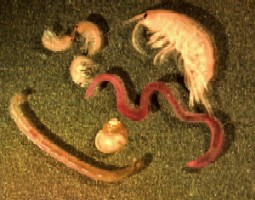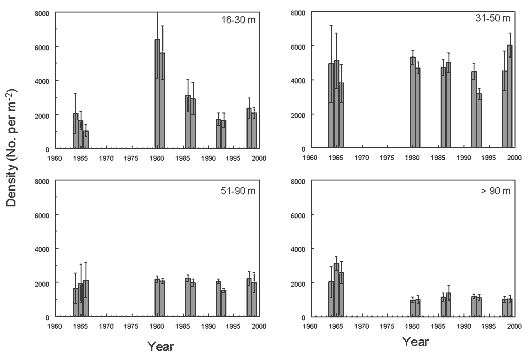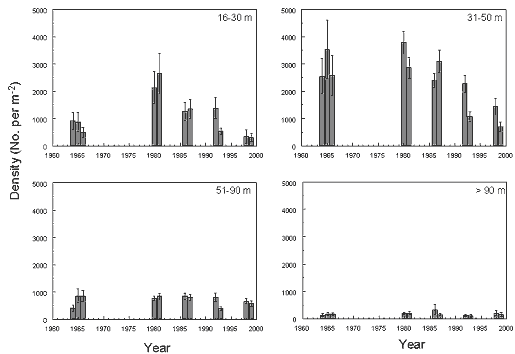 |
||||
Long-Term Trends in Benthic Populations
Primary Investigator:

Tom Nalepa () - NOAA/GLERL
Co-Investigators:
Greg Lang () - NOAA/GLERL
Dave Fanslow () - NOAA/GLERL
Executive Summary of Rationale
Macroinvertebrate populations have long been used to monitor the relative health of Great Lakes ecosystems. Community changes reflect relative impacts of various environmental variables, including nutrient enrichment and invasive species. Our benthic data collected in southern Lake Michigan extends back to 1980, and has been valuable in studying man-induced ecosystem changes. Recently, the data has been used to assess the distribution and population expansion of Dreissena (zebra mussel and quagga mussel).
Proposed Work
Current/Ongoing
In 2008, we will continue to prepare organisms for identification that were collected
in 2004-2006. Based on 2007 data, the quagga mussel population is still increasing, so
we plan to sample the 40 sites again in 2008.
Past Accomplishments
At its initiation in 1980, this project sampled at 40 sites in spring, summer,
and fall for two consecutive years, every five years. Samples were collected in
1980-81, 1986-87, 1992-93, and 1998-99. In these years, Diporeia and
dreissenids (zebra and quagga mussel) were documented because there was a dramatic
and rapid decline in populations of the former organism and an increase in
populations of the latter organisms. During sampling in 2004-2005, the entire
benthic macrointertebrate community was documented including Diporeia,
Oligochaeta, Chironomidae, Sphaeriidae, Gastropoda, and Dreissena.
Sampling was conducted in fall 2006 because of weather problems which prevented
sampling in fall 2005.
Although not included in the original project plan, sampling was also conducted in 2007 because of the rapidly expanding quagga mussel population in the southern basin. Between 2005 and 2006, quagga mussel densities increased dramatically at sites in each of four depth intervals (0-30 m, 31-50 m, 51-90 m, and › 90 m). For example, between 2005 and 2006, mean quagga mussel densities increased from 1,585 to 11,622•m-2 at 0-30m, from 6,810 to 13,410•m-2 at 31-50 m, from 658 to 4,754•m-2 at 51-90 m, and from 24 to 180•m-2 at › 90 m. Papers analyzing benthic changes through 1999 have been published to give summaries of trends and probable reasons for changes observed. A long-term plan is to complete identification of species found in the 2004 and 2005 samples, and summarize trends in the benthic community.
Scientific Rationale
Based on data collected in the mid-1960s and our own data collected between 1980 and 1999, we know that major changes have occurred in the benthic community of the southern basin of Lake Michigan. The dominant macroinvertebrate groups in Lake Michigan (at least prior to the introduction of the zebra mussel) were Diporeia, Oligochaeta, and Sphaeriidae. All three of these groups increased between the 1960s and the early 1980s. These increases were likely a response to increased phosphorus loads and pelagic productivity, which resulted in greater amounts of food settling to the bottom.
Phosphorus reduction programs in the 1970s led to lower benthic food inputs and a general decline in abundances of all three groups by 1986-87. These declines continued in 1992-93. However, between 1986-87 and 1992-93, Diporeia declined most dramatically in the south/southeastern portion of the basin and vanished by 1998-99 to depths of 50m in this portion of the lake. Oligochaetes and sphaeriids also declined between 1986-87 and 1992-93, but these declines occurred throughout the basin and were not as severe as Diporeia. Between 1992-93 and 1998-99, oligochaete abundances stabilized, but sphaeriid continued to decline. The zebra mussel was first collected in 1992 in shallow waters in the southern portion of the lake. Populations are now expanding northward along the eastern shoreline. Thus, the decline in Diporeia coincided both spatially and temporally with the introduction and spread of the mussels.
As of 2003, Diporeia is now gone to depths of 70 m in the south and southeastern portions of the basin and, while still present in the western portion of the lake, densities have declined by over 50%. The quagga mussel was first collected in 2001, and by 2002 was as abundant as zebra mussels at some sites. Quagga mussels are found at deeper depths (› 50 m), regions where zebra mussels are not found. Our future intentions are to:
- Document changes in the entire benthic community (Diporeia, Dreissena, Oligochaeta, Sphaeriidae, and others) between 1998-99 and 2004-2006
- Continue to monitor the rapid expansion of the quagga mussel population in the southern basin
Governmental/Societal Relevance
The introduction and spread of zebra and quagga mussels in Lake Michigan has led to dramatic changes in the food web, the most significant change being the total loss of the benthic amphipod Diporeia over wide areas. Diporeia is an important food item for many fish, and the loss of Diporeia has forced fish to shift feeding patterns, often with negative consequences. For example, the decline in Diporeia has led to a decrease in the condition and growth of lake whitefish and has altered the distribution and/or the diet of sculpin, bloater, and alewife. This project examines trends in benthic populations over time and provides this information to decision makers in the lake’s fishery. The public is also interested in invasive species, particularly zebra mussels and quagga mussels, and this project provides information on the status of mussel populations in the lake.
Relevance to Ecosystem Forecasting
This project is equally applicable to the themes of ecological prediction and aquatic invasive species. The two benthic organisms that have the greatest impact on the Lake Michigan ecosystem are presently changing at the most rapid rate. While quagga mussel populations are increasing, Diporeia is rapidly declining. While the exact mechanism in not clear, research strongly suggests that Diporeia is negatively impacted by the mussels. Diporeia plays a fundamental role in energy transfer throughout the food chain and its disappearance is disturbing current food web models. Tools such as network analysis are valuable in constructing past, and predicting new pathways with large-scale changes such as the loss of Diporeia.
While emphasis has been placed on the loss of Diporeia, understanding similar temporal and spatial shifts in the dreissenid population is important for model input given that recent ecological change in Lake Michigan has been driven by dreissenids and other invasives. If dreissenid populations continue to increase, it is predicted that the loss of Diporeia will continue. Subsequently, it can be predicted that fish dependent upon Diporeia as a food source will be forced to feed on other food items, leading to shifts in competitive interactions and cascading impacts on the food web.
Figure 1. Density trends in the amphipod Diporeia in the southern basin of Lake Michigan between the mid-1960s and 1998-99.

Figure 2. Density trends in Oligochaeta in the southern basin of Lake Michigan between the mid- 1960s and 1998-99.

Figure 3. Density trends in the Sphaeriidae in the southern basin of Lake Michigan between the mid-1960s and 1998-99.
Products
Presentations:
Nalepa, T. F. 2007. Aquatic invasive species and recent food web disruptions in the Great Lakes. Great Lakes Commission Meeting, October 2006, Duluth, MN.
Nalepa, T. F. 2007. Aquatic invasive species and recent food web disruptions in the Great Lakes. Invited Seminar Speaker, Purdue University, February 2007, West Lafayette, IN.
Nalepa, T. F. 2007. Aquatic invasive species and recent food web disruptions in the Great Lakes. Northwestern Community College, Invasive Species Course, June 2007, Traverse City, MI.
Nalepa, T. F., and Fanslow, D. L. 2007. A comparison of benthic changes in Lakes Michigan and Huron. 50th Conference on Great Lakes Research, IAGLR, May 2007, University Park, PA.
Publications:
Brochure: Decline in Lake Michigan Bottom Life
Nalepa, T.F., D.L. Fanslow, S.A. Pothoven, A.J. Foley III, G. A. Lang, S.C. Mozley, and
M.W. Winnell. Abundance and distribution of benthic macroinvertebrate populations in Lake Huron
in 1972 and 2000-2003. NOAA Technical Memorandum GLERL-140. NOAA, Great Lakes Environmental Research
Laboratory, Ann Arbor, MI, 33 pp. (2007).
ftp://ftp.glerl.noaa.gov/publications/tech_reports/glerl-140/tm-140.pdf
Nalepa, T.F., D.L. Fanslow, A.J. Foley III, G.A. Lang, B.J. Eadie, and M.A. Quigley.
Continued disappearance of the benthic amphipod Diporeia spp. in Lake Michigan:
Is there evidence for food limitation? Aquatic Invaders 17(3):1-12 (2006).
http://www.glerl.noaa.gov/pubs/fulltext/2006/20060018.pdf
Barbiero, R. P., T. F. Nalepa, and M. L. Tuchman. Phytoplankton, zooplankton, and benthos.
In The State of Lake Huron in 1999. M.P. Ebener (Ed.). Special Publication 05-02. Great Lakes
Fishery Commission, Ann Arbor, MI, 33-41 (2005).
http://www.glerl.noaa.gov/pubs/fulltext/2005/20050029.pdf
Nalepa, T.F., D.L. Fanslow, G.A. Lang, and S.A. Ruberg. Recent trends in benthic macroinvertebrate populations in Lake Michigan. In State of Lake Michigan (SOLM) - Ecology, Health, and Management. T. Edsall and M. Munawar (eds.). Ecovision World Monograph Series, Aquatic Ecosystem Health and Management Society, 269-292 (2005).
Neilson, M.A., D.S. Painter, G. Warren, R.A. Hites, I. Basu, D.V.C. Weseloh, D.M. Whittle, G. Christie, R. Barbiero, M. Tuchman, O.E. Johannsson, T.F. NALEPA, T.A. Edsall, G. Fleischer, C. Bronte, S.B. Smith, and P.C. Baumann. Ecological monitoring for assessing the state of the nearshore and open waters of the Great Lakes. Environmental Monitoring and Assessment 88:103-117 (2003).
Nalepa, T.F. Indicator #93: the benthic amphipod Diporeia spp. In State of the Lakes Report. Great Lakes National Program Office, EPA (2003).
Madenjian, C.P., G.L. Fahnenstiel, T.H. Johengen, T.F. Nalepa, H.A. Vanderploeg, G.W. Fleischer,
P.J. Schneeberger, D.M. Benjamin, E.B. Smith, J.R. Bence, E.S. Rutherford, D.S. Lavis, D.M. Robertson,
D.J. Jude, and M.P. Ebener. Dynamics of the Lake Michigan food web, 1970-2000. Canadian Journal
of Fisheries and Aquatic Sciences 59:736-753 (2002).
http://www.glerl.noaa.gov/pubs/fulltext/2002/20020015.pdf
Nalepa, T.F., D.W. Schloesser, S.A. Pothoven, D. Hondorp, D.L. Fanslow, M. Tuchman, and G. Fleischer.
First finding of the amphipod Echinogammarus ischnus and the mussel Dreissena bugensis in
Lake Michigan. Journal of Great Lakes Research 27(3):384-391 (2001).
http://www.glerl.noaa.gov/pubs/fulltext/2001/20010010.pdf
Nalepa, T.F., D.J. Hartson, J. Buchanan, J.F. Cavaletto, G.A. Lang, and S.J. Lozano. Spatial variation in density, mean size, and physiological condition of the holoarctic amphipod Diporeia spp. in Lake Michigan. Freshwater Biology 43:107-119 (2000).
Nalepa, T.F., G.A. Lang, and D.L. Fanslow. Trends in benthic macroinvertebrate populations in
southern Lake Michigan. Verh. Internat. Verein. Limnol. 27:2540-2545 (2000).
http://www.glerl.noaa.gov/pubs/fulltext/2000/20000004.pdf
Nalepa, T.F. Dramatic changes in benthic macroinvertebrate populations in southern Lake Michigan. Aquatic Nuisance Species Update 4:(30) (1999).
Nalepa, T.F., D.J. Hartson, D.L. Fanslow, G.A. Lang, and S.J. Lozano. Declines in benthic
macroinvertebrate populations in southern Lake Michigan, 1980-1993. Canadian Journal of
Fisheries and Aquatic Sciences 55(11):2402-2413 (1998).
http://www.glerl.noaa.gov/pubs/fulltext/1998/19980005.pdf
Landrum, P.F., and T.F. Nalepa. A review of the factors affecting the ecotoxicology of
Diporeia spp. J. Great Lakes Res. 24: 889-904. (1998)
http://www.glerl.noaa.gov/pubs/fulltext/1998/19980010.pdf


